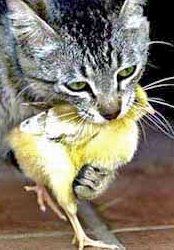
Cats kill 1.4 billion to 3.7 billion birds and 6.9 billion to 20.7 billion small mammals in the U.S. every year. Those startling statistics were recently revealed in a paper published in Nature Communications and picked up by media outlets from Comedy Central to the New York Times and Smithsonian.
I don’t know if cats have nine lives, but it’s evident they lead two lives — the cat that rubs its silken fur across your leg, purring contentedly, and the genetically hardwired wildlife stalker.
As a certified wildlife rehabilitator, I remember several wildlife hospitals telling me that they wouldn’t be in business if it were not for outside cats. Like other non-native species, domestic cats imperil the delicate balance of nature that has endured for thousands of years.
Although many people are involved with the plight of free-roaming cats, the authors of the new findings, researchers from the Smithsonian’s Migratory Bird Center and the U.S. Fish and Wildlife Center, contend that trap/neuter/release programs for feral cats are undertaken with no consideration for the consequences to native animals.
The Audubon Organization suggests that talking with your neighbors and asking them to keep their cat indoors or confined to their yard can help eliminate a problem at its source. That could create a big case of “conflict avoidance” in many of us, though. Check out other ideas at http://athome.audubon.org/helping-birds.
How can we make our yards more bird-friendly?
– Build a brush pile where ground-feeding birds, like juncos and towhees, and small mammals can hide from predators. I built mine at the foot of a madrone tree the squirrels use to get to the feed and water I leave for them and the birds. You can locate them along hedge rows and at the corners of fences. Start with spring prunings from trees and later in the year throw your Christmas tree on it. Don’t use piles of leaves and grass clippings that erode quickly and don’t allow for passages.
– Plant thick bushes like our native huckleberry. Thick hedges are sanctuaries for small animals.
– Rent cages from the County Animal Shelter for capturing cats and transferring them to the shelter.
– Use water pump guns laced with vinegar to keep cats out of yards.
How can cat owners help?
– Molly Richardson of Native Animal Rescue swears by the CatBib that attaches to the collar and breaks the striking stride, but otherwise does not interfere with movement. Buy at www.catgoods.com.
– Build or buy an outside cat condo made of wire so your cat can appreciate nature without doing any harm.
– Keep your cats inside. Not only will you save wildlife, but you won’t lose your furry friend to coyotes, bobcats and cars. According to the American Humane Society, cats that are allowed to roam outside live an average of three years while indoor cats typically reach an average age of 15 years.
– Train your cat to walk on a leash. I have to smile when I see owners parading their kitties at parks like the Covered Bridge, Loch Lomond, and Highlands.
– Spay and neuter.
We are entering the dangerous baby season for many of our native animals. For example, after a young nestling grows into a fledgling, the bird will attempt to fly. At this time, the bird is at its most vulnerable and may end up on the ground, and because at this stage the fledgling sleeps so soundly, it becomes easy prey to free-roaming cats.
If you find a baby bird and it is injured, unhealthy, or is being stalked by a cat, place it on a warm cloth in the bottom of a paper bag or small box with ventilation holes. Keeping a baby animal warm is of vital importance to insure survival.
Then call Native Animal Rescue at 831-462-0726 or take the animal to 1855 17th Ave., Santa Cruz, which is open 24-7 for information: www.nativeanimalrescue.org/.
Whatever you do, do not keep wild animals. As a volunteer, I have picked up a fawn which was kept overnight. The baby died a few hours after I delivered to NAR. Baby birds must be fed every 30 minutes from sunrise to sunset. Even with expert care, the survival rate is only 1 percent. It is also against the law to harbor wildlife.
Native Animal Rescue is a community of skilled rehabilitators across Santa Cruz County trained to diagnose, treat, rehabilitate, and release wild animals back to the wild in accordance with Department of Fish and Game standards.
Please keep NAR’s number and address with you at all time. You never know when you will have an opportunity to save a wild animal.
– Carol Carson, M.Ed., is a naturalist, writer, and educator.












